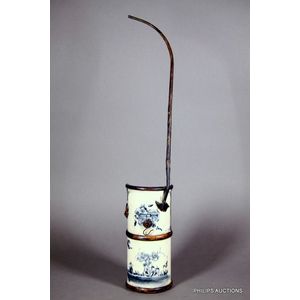19th Century Chinese Blue and White Opium Burner
An antique Chinese blue and white porcelain opium burner, Qing Dynasty, probably 19th century, the metal mounted cylindrical burner with a stepped shield and long pipe, decorated with an underglazed figure in a landscape scene upon a crackle ground; bearing Yongzheng reign marks with small variations underside, height 52.5 cm
You must be a subscriber, and be logged in to view price and dealer details.
Subscribe Now to view actual auction price for this item
When you subscribe, you have the option of setting the currency in which to display prices to $Au, $US, $NZ or Stg.
This item has been sold, and the description, image and price are for reference purposes only.
- Ming Dynasty - The Ming Dynasty was a ruling dynasty of China from 1368 to 1644. It succeeded the Yuan Dynasty and preceded the Qing Dynasty. The Ming Dynasty was established by Zhu Yuanzhang, a former Buddhist monk who became a rebel leader and eventually overthrew the Mongol Yuan Dynasty. During the Ming Dynasty, China experienced a period of relative stability and prosperity. The government was centralized and bureaucratic, with the emperor at the top of the hierarchy. The Ming Dynasty is known for its cultural achievements, including the development of porcelain, the invention of movable type printing, and the construction of the Great Wall of China.
- Qing Dynasty - The Qing Dynasty was the last imperial dynasty of China, ruling from 1644 to 1912. It was established by the Manchu people, who originated from the northeastern region of China. The Qing Dynasty was preceded by the Ming Dynasty and followed by the Republic of China.
- Crackling and Crackle as a Decorative Technique - Crackle, also known as crackling, is a decorative technique that has been used in China for centuries. It is believed to have originated during the Song Dynasty (960?1279 AD) and was primarily used in the production of ceramics, lacquerware, and furniture. The crackling effect was achieved by applying a glaze or lacquer that was formulated to crack during firing, creating a crackled pattern on the surface of the item.
During the Ming Dynasty (1368?1644 AD), crackle became a highly sought-after decorative technique, and it was used to create intricate and beautiful designs on ceramics and lacquer ware.
In Western decorative arts, crackle / crackling came into use during the Art Nouveau movement in the late 19th and early 20th century. The crackling effect was used to create a sense of movement and fluidity in the design of Art Nouveau pieces.
It was also used in the 1920s and 1930s during the Art Deco movement. - Crackles / Cracquelure - In ceramics, crackles may be introduced intentionally during the firing process, as was often the case with Oriental ceramics, and are known as artificial crackles. Natural crackles occur with age, and if the glaze is transparent, may be difficult to detect. Natural crackles may not cover the whole surface of the object and may be uneven in size.
This item has been included into following indexes:
Visually similar items

An 18ct gold amethyst pendant; corner claw set with a 15 x 12.5 amethyst. Wt. 3.8g
Sold by
in
for
You can display prices in $Au, $US, $NZ or Stg.

Pair 13 mm broom pearl and diamond earrings on 18ct gold hooks
Sold by
in
for
You can display prices in $Au, $US, $NZ or Stg.

Small antique French scales and weights, 26 cm high, 27 cm wide
Sold by
in
for
You can display prices in $Au, $US, $NZ or Stg.

Sterling silver ladies cuff bangle marked 925, 34g, 5 cm inside measurement
Sold by
in
for
You can display prices in $Au, $US, $NZ or Stg.
